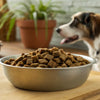Can Dry Dog Food Expire? Understanding Shelf Life and Storage Tips for Pet Owners
- Houndsy
Table of Contents
- Introduction
- Understanding Dog Food Expiration
- How to Store Dry Dog Food Properly
- Nutritional Value and Expiration
- Can Dogs Eat Expired Food?
- Conclusion
Introduction
Did you know that the average shelf life of dry dog food is around 12 to 18 months? For many pet owners, this statistic raises an important question: can dry dog food expire? As responsible dog parents, we must ensure that our furry friends receive the best nutrition possible, and understanding the shelf life of their food is a crucial part of that responsibility.
In this blog post, we aim to delve into the life cycle of dry dog food, examining its expiration, the signs of spoilage, and the best storage practices that can help us maximize the freshness and nutritional quality of our pets' meals. By the end of this article, you will have a comprehensive understanding of how to keep your dog’s food safe and healthy, ensuring that every bowl is filled with the best for your beloved companion.
Let’s embark on this journey together as we explore the ins and outs of dry dog food shelf life, storage methods, and how we can enhance our daily feeding routine with thoughtful practices.
Understanding Dog Food Expiration
The Basics of Dog Food Shelf Life
Dry dog food, commonly known as kibble, is designed to have a long shelf life, thanks to the way it is processed and packaged. The primary factors contributing to its longevity include:
- Moisture Content: Dry kibble typically contains only 10% moisture, which inhibits the growth of mold and bacteria.
- Preservatives: Many commercial dog foods are formulated with preservatives that help maintain freshness over time.
- Packaging: The packaging is designed to keep air and light out, which can degrade the food faster.
However, even with these advantages, dry dog food does have a shelf life. Generally, an unopened bag can last between 12 to 18 months from the date of manufacture, but once opened, it should ideally be consumed within 6 weeks for optimal freshness.
Signs of Expired Dog Food
Knowing how to tell if your dog’s food has gone bad is essential. Here are some indicators to look for:
- Odor Changes: If the kibble emits a sour, rancid, or otherwise unusual smell, it may have spoiled.
- Visual Signs: Discoloration, presence of mold, or pest infestations are clear signs that the food should not be consumed.
- Texture Changes: If the kibble has become moist and crumbly, it may have absorbed moisture, leading to spoilage.
- Your Dog's Reaction: If your dog refuses to eat the food or only takes a few bites, it may be a sign that the food is no longer appealing or safe.
The Role of Expiration Dates
Most dog food manufacturers print a “best by” or “use by” date on the packaging. This date indicates how long the food is expected to retain its optimal quality, but it's important to note that the food may still be safe to consume shortly after this date, provided that it has been stored correctly.
While the “best by” date is a helpful guideline, it does not necessarily mean that the food is dangerous after that date. However, the nutritional value may be compromised, and it’s essential to evaluate the food for any signs of spoilage before feeding it to your dog.
How to Store Dry Dog Food Properly
Best Practices for Storage
Proper storage is vital in prolonging the life of dry dog food. Here are some tips to ensure your pet's kibble stays fresh for as long as possible:
- Keep It in the Original Packaging: The original bag is designed to protect the food from air, moisture, and light. If you need to transfer it to another container, consider using an airtight bin while keeping the original packaging inside to retain vital information.
- Seal it Tightly: After opening, roll down the top of the bag and secure it with a clip, or transfer it to a sealed container.
- Store in a Cool, Dry Place: Heat, humidity, and sunlight can all degrade the quality of the food. Aim for a storage area that remains cool and dark, ideally below 80°F (27°C).
- Avoid Bulk Purchases: If you have a smaller dog or a household with fewer pets, consider buying smaller bags of food to ensure that it is consumed while still fresh.
- Regularly Inspect the Food: Make it a habit to check for any signs of spoilage each time you feed your dog. This includes smelling the food and looking for any discoloration or texture changes.
Practical Solutions for Freshness
We understand that keeping pet food fresh can sometimes feel overwhelming, but small adjustments can make a significant difference. Here are a few practical solutions:
- Use a Pet Food Storage Container: These containers are designed to keep food fresh by preventing air from getting in. Look for options that are airtight and made from food-safe materials.
- Consider Portion Control: Using a product like the Houndsy Kibble Dispenser not only makes feeding time easier but also helps maintain the freshness of the food by dispensing it directly from the original packaging while minimizing exposure to air.
Nutritional Value and Expiration
The Impact of Expiration on Nutrition
As dry dog food approaches its expiration date, its nutritional content begins to decline. Important vitamins, minerals, and fatty acids may degrade or become less bioavailable. This means that while your dog may still be able to consume the food without immediate health issues, they might not be receiving the nutrients they need for optimal health.
- Vitamins and Minerals: Essential vitamins like A, D, E, and K can degrade over time, affecting your dog's overall health.
- Omega Fatty Acids: These beneficial fats can turn rancid, leading to potential digestive issues or skin problems in your dog.
Long-term Effects of Feeding Expired Food
Feeding your dog expired food can lead to a range of health issues, including:
- Gastrointestinal Disturbances: Consuming rancid fats can cause upset stomach, diarrhea, and vomiting.
- Nutritional Deficiencies: Over time, a diet lacking in essential nutrients can lead to more severe health problems, including liver damage or inflammation.
Can Dogs Eat Expired Food?
The Risks of Feeding Expired Dog Food
While it may be tempting to feed your dog expired dry food, we encourage you to think twice. If the food is beyond its “best by” date, it may not be harmful in small amounts, but it is best to err on the side of caution:
- Potential for Illness: Expired food could harbor harmful bacteria or toxins that could make your dog sick.
- Loss of Nutritional Quality: As mentioned earlier, the food may not provide the necessary nutrients your dog requires.
Alternatives to Expired Food
If you find yourself without fresh dog food, consider temporary alternatives that are safe for dogs. Here are some dog-safe options you might have in your kitchen:
- Cooked Meat: Plain, cooked chicken or beef can be a tasty treat for your pup.
- Rice or Pasta: These carbohydrates can be a good filler if your dog is in need of a meal.
- Vegetables: Carrots, peas, or green beans can be healthy additions to your dog's diet.
Conclusion
In summary, understanding the shelf life of dry dog food and how to store it properly is crucial for ensuring our pets receive the best nutrition. By recognizing the signs of spoilage and adhering to storage best practices, we can prolong the freshness of our dogs' meals.
We encourage you to regularly check your dog’s food and consider investing in products like the Houndsy Kibble Dispenser to enhance your feeding routine while keeping food fresh. After all, our furry friends deserve the best!
FAQ
How long does dry dog food last after opening?
Once opened, dry dog food is best consumed within 6 weeks to ensure freshness and nutritional quality.
Can expired dry dog food make my dog sick?
While not all expired dog food will cause illness, it can lead to digestive upset and nutritional deficiencies.
What should I do if my dog's food has gone bad?
If you notice any signs of spoilage, it’s best to discard the food and provide a temporary meal using safe alternatives.
How should I store dry dog food?
Store dry dog food in its original packaging in a cool, dry place. Consider using an airtight container for added freshness.
Is it safe to feed my dog homemade meals instead of commercial dog food?
While homemade meals can be safe and nutritious, it's essential to ensure they meet your dog’s dietary needs. Consult with your veterinarian for guidance.
By following these guidelines and insights, we can ensure our dogs enjoy meals that are not only delicious but also nutritious and safe.













